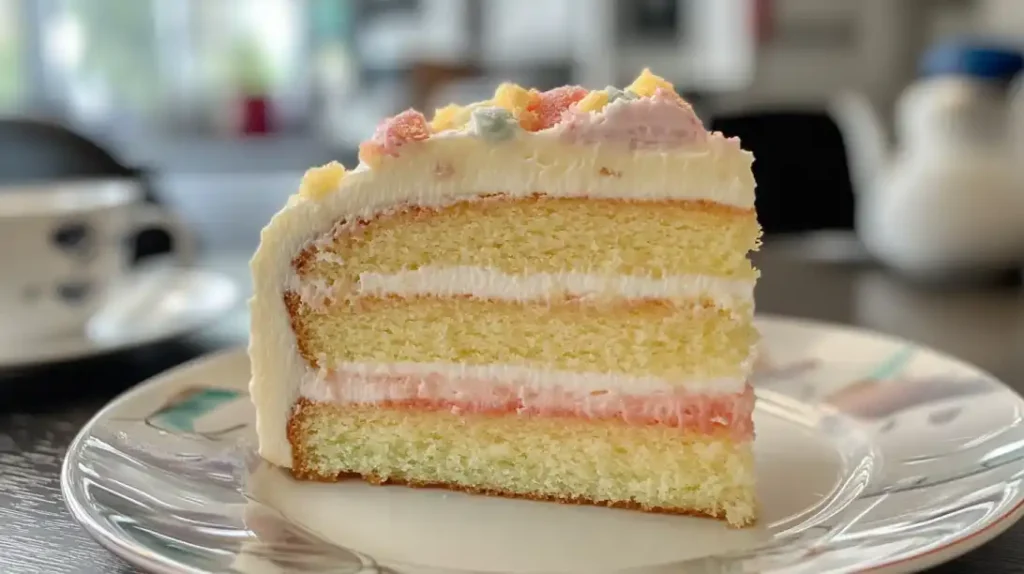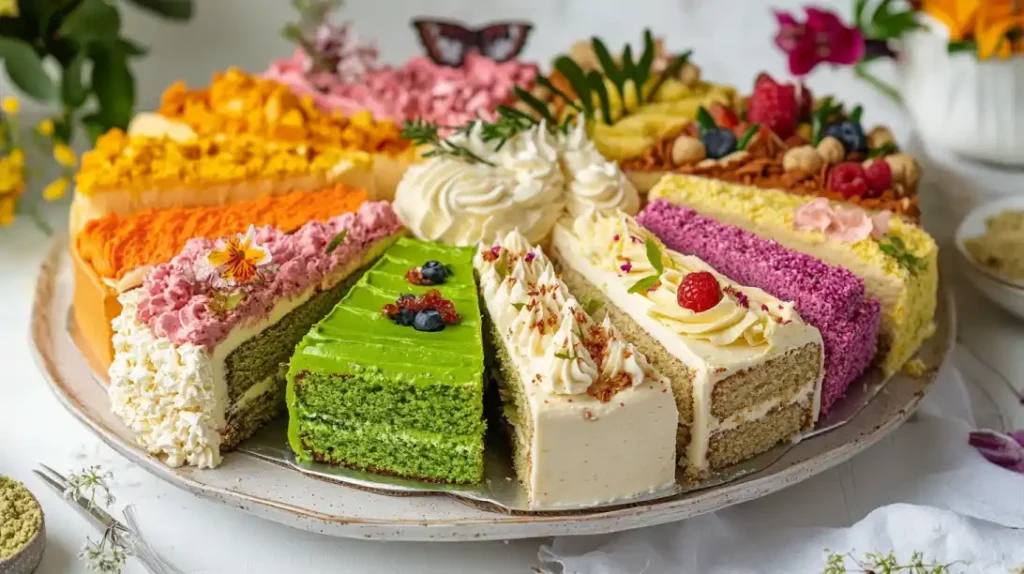The princess cake, with its iconic dome shape and layers of sweetness, is a beloved dessert originating from Sweden. This layered cake is not only a visual masterpiece but also a flavorful delight. Whether you’re a baking enthusiast or someone who simply enjoys discovering global desserts, learning about the princess cake is a truly rewarding experience.
Table of contents
A Royal History of the Princess Cake
The story of the princess cake is as rich as the cake itself. Originating in early 20th-century Sweden, it was first crafted by Jenny Åkerström, a cooking instructor who gained fame for teaching the daughters of Prince Carl, Duke of Västergötland. The three princesses Margaretha, Märtha, and Astrid adored this particular cake so much that people associated it with their royal family, eventually naming it the “princess cake.”

Initially called “grön tårta” (green cake) because of its signature pastel-green marzipan covering, the name evolved to reflect the royal connection. Over time, the cake’s fame extended well beyond Sweden, becoming a symbol of Scandinavian confectionery artistry. It is still a centerpiece at celebrations such as birthdays, weddings, and even traditional fika gatherings.
To learn more about other European culinary treasures, explore our guide to savory brulee recipes, which shares the same level of decadence as the princess cake.
Traditional Princess Cake Recipe
This recipe serves 10-12 people. Allow at least a few hours for preparation and assembly.
Ingredients
The Sponge Cake:
- 4 large eggs
- 1 cup (200 g) granulated sugar
- 1 cup (120 g) all-purpose flour
- 1 tsp baking powder
- 2 tbsp unsalted butter, melted
- 2 tbsp milk
The Pastry Cream:
- 2 cups (500 ml) whole milk
- 4 large egg yolks
- 1/2 cup (100 g) granulated sugar
- 3 tbsp cornstarch
- 1 tsp vanilla extract
The Whipped Cream Dome:
- 2 cups (500 ml) heavy whipping cream
- 2 tbsp powdered sugar
- 1 tsp vanilla extract
Assembly:
- 1/2 cup (120 g) raspberry jam
- 16 oz (450 g) green marzipan
- Powdered sugar for dusting
- Pink marzipan or a small edible rose for decoration
What Makes a Princess Cake Unique?
The princess cake stands out as one of the most elegant and visually stunning desserts in the world, combining simplicity and sophistication. Its uniqueness lies not only in its exquisite appearance but also in the harmonious blend of textures and flavors that make it irresistible. Every component of this iconic dessert contributes to its charm, making it a favorite for special occasions and everyday indulgence alike.
For more delicate techniques, check out our tips on making soft and chewy cookies, which also emphasizes texture and balance.
1. The Distinctive Marzipan Dome
The pastel-green marzipan covering is undoubtedly the most recognizable feature of the princess cake. Bakers carefully roll out the smooth, almond-flavored layer and drape it over the dome-shaped cake to create a seamless and polished appearance. The green color symbolizes softness and elegance, often complemented by a pink marzipan rose or edible flower on top. While some may use fondant as a substitute for marzipan, its nutty sweetness defines the cake’s signature flavor.

2. A Perfectly Balanced Flavor Profile
It is celebrated for its perfect balance of flavors. Each bite offers a delightful combination of:
- Light and airy sponge cake: This forms the base and structure of the dessert, adding a subtle sweetness and fluffiness.
- Tart raspberry jam: This layer adds a sharp, fruity contrast to the richness of the cream.
- Creamy pastry cream: Velvety and sweet, this custard-like filling brings richness and depth.
- Whipped cream dome: The fluffy whipped cream adds lightness and a silky texture that ties the layers together.
This symphony of flavors ensures that the cake is indulgent without being overly heavy, making it a versatile choice for various palates.
3. The Signature Dome Shape
The dome shape of the princess cake is a defining characteristic that sets it apart from other layered cakes. This unique design is achieved by piling whipped cream on top of the stacked sponge layers and carefully shaping it into a smooth, rounded form. The dome is then covered with marzipan, resulting in a cake that is as visually impressive as it is delicious.
4. Versatility for Special Occasions
While the princess cake is deeply rooted in Swedish tradition, it has become a go-to dessert for celebrations worldwide. Its elegant design makes it a centerpiece at weddings, birthdays, and anniversaries. Moreover, its ability to be customized for dietary preferences such as vegan, gluten-free, or alcohol-free variations enhances its versatility. For instance, coconut cream can replace whipped cream in a vegan version, and almond flour can be used in place of traditional flour for a gluten-free adaptation.
5. A True Representation of Scandinavian Elegance
The princess cake epitomizes Scandinavian baking traditions, which often emphasize clean flavors, minimalistic designs, and high-quality ingredients. Unlike more decadent desserts, this cake’s subtle sweetness and fresh ingredients make it feel light and refined. It reflects a balance between indulgence and simplicity, qualities that are integral to Nordic culinary culture.
6. A Testament to Craftsmanship
Creating a princess cake requires precision and skill, especially when it comes to assembling the layers and achieving the signature dome shape. The marzipan layer must be rolled out evenly and applied carefully to avoid tears or cracks, making the process a test of craftsmanship. Despite its seemingly complex preparation, the satisfaction of mastering this cake makes it an attractive challenge for home bakers.
Step-by-Step Guide: Making a Princess Cake
Creating a princess cake may seem intimidating at first; however, with some patience and the right approach, it’s entirely achievable. Follow these steps carefully for the best results:
- Prepare the Sponge Cake
Start by baking three layers of light sponge cake. To ensure the best texture, allow the layers to cool completely before assembly. - Add the Filling
Begin by spreading a thin layer of raspberry jam on each sponge layer. Then, pipe or spread pastry cream over the jam. Repeat this process for each layer to create the perfect flavor balance. - Create the Dome
Next, pile whipped cream on top of the stacked layers. Using a spatula, shape the whipped cream into a smooth, rounded dome. This step is crucial for achieving the cake’s signature look. - Cover with Marzipan
Roll out pastel-green marzipan into a thin sheet. Carefully drape it over the dome, smoothing it down gently with your hands to avoid tearing. - Decorate
Finally, dust the cake with powdered sugar and add a pink marzipan rose to complete the classic decoration.
If you’re looking for other crowd-pleasing desserts, don’t miss our Cinnabun recipes, perfect for sweet enthusiasts.
Global Variations of the Princess Cake
While the princess cake is a quintessential Swedish dessert, its popularity has inspired creative variations across the globe. Each adaptation maintains the essence of the original while incorporating unique regional flavors, ingredients, or traditions. These global variations ensure that the princess cake can be enjoyed by people from diverse culinary cultures, making it a truly universal delight.
For more global baking inspiration, consider trying our crookie, which also emphasize creative substitutions.

1. Vegan Princess Cake
The rise of plant-based diets has led to a vegan version of the princess cake, allowing those who avoid animal products to enjoy its timeless charm. Bakers replace traditional whipped cream with alternatives like coconut cream or soy-based whipping cream, which whip up to a fluffy texture. They also use egg substitutes such as aquafaba (chickpea water) or flaxseed meal to create a light and airy sponge cake. To maintain the almond flavor without compromising dietary restrictions, bakers often choose vegan marzipan made without honey.
2. Gluten-Free Princess Cake
For those with gluten sensitivities, the princess cake can be adapted by replacing wheat flour with almond flour, rice flour, or a gluten-free flour blend. Almond flour not only keeps the cake light but also enhances the nutty flavor profile, complementing the marzipan perfectly. This variation is a popular choice for gluten-free celebrations and retains the indulgent qualities of the original.
3. Alcohol-Free Princess Cake
Traditionally, some variations of the princess cake include a splash of liqueur, such as kirsch or rum, in the whipped cream or pastry cream. However, alcohol-free versions eliminate these ingredients to cater to a broader audience, including children and those who avoid alcohol for cultural or personal reasons. Substituting fruit juice, such as orange or raspberry juice, provides a flavorful alternative while keeping the cake family-friendly.
4. Japanese Matcha Princess Cake
In Japan, the princess cake has been given a matcha twist, incorporating the vibrant green tea powder into the marzipan or sponge layers. The slightly bitter, earthy flavor of matcha complements the sweetness of the pastry cream and raspberry jam, creating a sophisticated dessert that appeals to matcha enthusiasts. The green color of the marzipan is often enhanced with natural matcha, giving the cake an authentic and vibrant hue.
5. Middle Eastern Princess Cake
In the Middle East, variations of the princess cake incorporate flavors like rose water or orange blossom water, infusing the cake with a delicate floral aroma. Pistachios, another regional favorite, are often ground and mixed into the marzipan or sprinkled as a garnish. These adaptations celebrate the region’s rich dessert culture while maintaining the structural and visual elements of the classic princess cake.
6. Tropical Princess Cake
In tropical regions, bakers reimagine the princess cake with flavors like coconut and passion fruit. They replace traditional whipped cream with coconut cream, adding a tropical twist to the flavor.
Additionally, layers of passion fruit curd or mango jam replace raspberry jam, offering a tangy and exotic flair. This version is particularly popular for summer celebrations or seaside weddings.
7. Chocolate Princess Cake
For chocolate lovers, some variations of the princess cake include chocolate sponge layers or chocolate-flavored marzipan. The pastry cream may also be infused with cocoa powder to create a rich and indulgent filling. This version retains the iconic dome shape and layered structure while offering a new take on the original flavor profile.
8. Rainbow Princess Cake
Bakers add a modern and playful twist to the princess cake with the rainbow variation, dyeing the sponge layers in bright colors to create a rainbow effect when sliced.
This version is especially popular for children’s parties or pride celebrations, as it combines the elegance of the traditional cake with a fun and colorful surprise.
Expert Tips for Perfect Results
Even experienced bakers may encounter challenges when making a princess cake. However, by following these expert tips, you can achieve professional-looking results:
- Always chill the whipped cream before assembling the dome to prevent it from melting.
- Roll the marzipan evenly using a rolling pin, which ensures a smooth finish.
- If cracks appear in the marzipan, patch them with small, softened marzipan pieces.
Additionally, take your time during the assembly process to ensure each layer is balanced and visually appealing.
FAQs About Princess Cake
What makes a princess cake different from other cakes?
Its distinct layers of sponge, cream, and marzipan set it apart, making it both visually stunning and delicious.
Is it difficult to make a princess cake at home?
Although it requires some practice, even beginners can succeed with patience and proper preparation.
Can marzipan be substituted with fondant?
Yes, it can, but fondant lacks the almond flavor that defines the traditional princess cake.
How long does it stay fresh?
When stored in the refrigerator, the cake remains fresh and flavorful for up to three days.
Conclusion
The princess cake is more than just a dessert—it is a symbol of elegance, tradition, and culinary artistry. From its royal origins in Sweden to its countless global variations, this cake has captured the hearts and taste buds of people around the world. Its signature dome shape, pastel-green marzipan, and perfectly balanced layers of sponge, cream, jam, and marzipan make it a timeless favorite for any occasion.
What sets the princess cake apart is its versatility. Whether you’re embracing the classic Swedish recipe or exploring creative adaptations like vegan, gluten-free, or matcha-infused versions, this cake offers endless possibilities. It’s a testament to how tradition can blend beautifully with innovation.
Making a princess cake at home is a rewarding experience, combining creativity, precision, and, of course, delicious results. So why not give it a try? Whether you’re celebrating a birthday, a wedding, or simply a love for baking, the princess cake is the perfect centerpiece. Its beauty and flavor ensure it remains a royal treat for generations to come.

